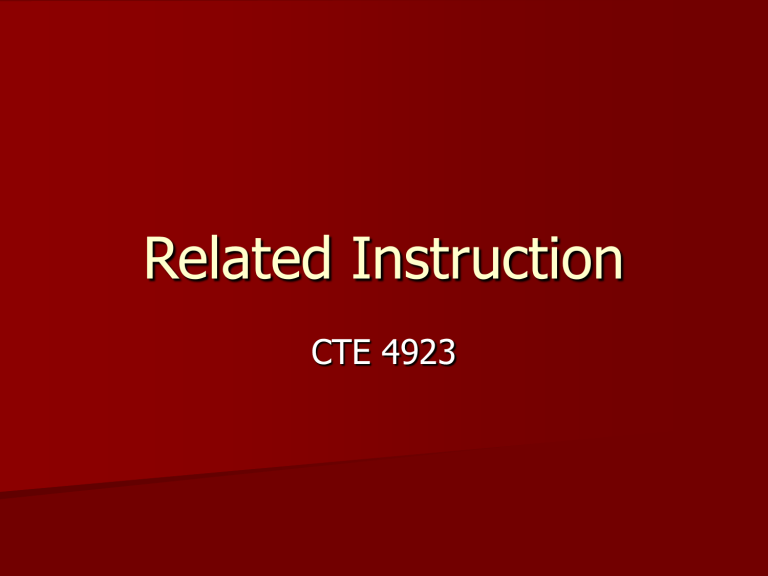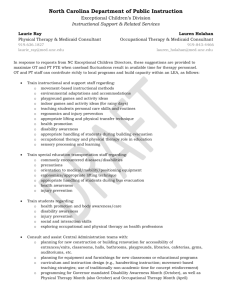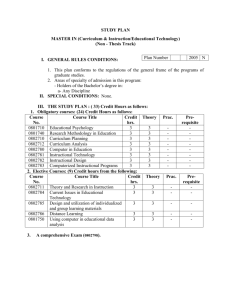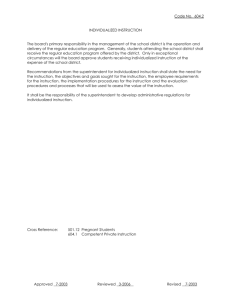Related Instruction

Related Instruction
CTE 4923
Program Components
Related instruction
On-the-job training
Student organization activities
Related Instruction
In-school instruction students receive
In conjunction with OTJ training
Provides theory, background, and technical skills
Serves as basis for other activities
Ensures all experiences are interrelated
Minimum 200 minutes per week required
Your Responsibilities
Supervising OTJ instruction
Planning and conducting in-school instruction related to OTJ experiences and in the student organization
Serving as advisor to student organization
Types of Related Instruction
General – basic skills and general occupational information
Technical – skills, attitudes, and concepts
Specific – individualized for each student’s needs, interests, and abilities
General Related Instruction
All students need to succeed in achieving career goals
Examples:
– Improving reading, writing, and math skills
– Basic occupational skills – typing, making change, accurately measuring
– General skills, information, and attitudes – interpersonal relations, payroll, benefits, locating jobs, interviewing, selecting jobs
Technical Related Instruction
Needed by two or more students
Generally grouped by specific occupations
Prepared separately for students in different occupational areas
Example: dental terminology
Specific Related Instruction
Totally individualized
Identified when developing training plan
Training specially geared to student’s specific situation and needs
Skills necessary for specific occupational field
Includes specific skills, knowledge, and attitudes required to progress in field
Specific Related Instruction
Examples
Manipulating tools and equipment
Gathering, processing, communicating, or applying technical information
Constructing, assembling, or combining elements
Performing a service
Determining Topics
Training plans
Advisory committee
State’s/school’s suggested curriculum
Occupational analyses
Student organization activities
Coordination visits
Students
General Topics
What topics would fit the general category???
Activity
Read and analyze the training plans.
List at least 3 general related topics.
Divide the students into occupational groups. List at least 3 topics for technical related instruction.
List at least 3 topics for specific related instruction for each student.
What further input would you need to determine additional topics to cover?
Units of Instruction
– Orientation to Cooperative Education
– Entering the World of Work
– Using Safety on the Job
– Understanding the Company where You Work
– Developing Human Relations Skills
– Developing Communication Skills
Units of Instruction (cont.)
– Understanding the Law
– Developing Individual Potential
– Coping with Stress and Conflict
– Meeting Your Adult Responsibilities
– Using Job Related Math
– Understanding Taxation
– Preparing for the Future
Units of Instruction (cont.)
– Analyzing Employment Possibilities
– Understanding Economic Systems
– Conserving Resources
Instructional Methods
What instructional methods would you utilize???
Instructional Methods
Large group presentations (general)
Individually or in small groups (general)
Projects (technical and specific)
– Prepare students for planning and conducting the projects
– Ensure that their planning is clear and thorough
– Monitor their progress on a regular basis
Instructional Methods
Role playing
Reading assignments
Practice/application
Case studies
Observations/interviews
Oral reports
Guest speakers!!!
Instructional Materials
What materials would you use???
Instructional Materials
Textbooks
Journals
Films
Workbooks
Modules or learning activity packages
Training manuals
Computer-assisted instruction
Locating Instructional Materials
Advisory committee
Employers and/or OTJ instructors
Other educators
Commercial publishers
Curriculum guides – reference list
Illinois Office of Educational Services
Scheduling Related Instruction
Certain days of week = type of instruction
Early in year – more time on general
Later in year – more time on specific
Specific included when needed
Be flexible to meet students’ changing needs
Specific
General
Start of term End of term
Scheduling Suggestions
Early class session topics
– Orientation to program – forms, policies, etc.
– Function of student organization
– Safety
Correlate OTJ with classroom instruction
Foster ability to work independently
Consider immediacy of student need in structuring topics
Evaluating Instruction
General – frequently utilize traditional
Specific
– Quantity and quality of work
– Related to objectives, standards, or outcomes
– Assessing growth in meeting outcomes
Facilities, Equipment, Supplies
Classroom close to building entrance
Adjoining teacher-coordinator office
Individual storage bins/drawers
Storage cabinets for materials, references
Magazine racks
Tables for learning activities
Career development materials
Individualized Instruction
Needs, abilities, and interests are priority
Become more active, involved, and responsible for own instruction
Teacher becomes manager and/or guide
Clear objectives direct students
Alternative and optional experiences
Individualized Instruction (cont.)
Strategies reach individuals
– Games, role-playing, simulations, case studies, projects, modules, peer instruction, research, computerized modules
Variety of media and resources
Environment is flexible
Evaluated on individual performance
Limitations of
Individualized Instruction
Lack of suitable materials
Additional work and complex planning
Not all students adapt well
Evaluation might not fit school’s grade report timeline
Success with
Individualized Instruction
Identify student goals
Carefully develop objectives to reach goals
Provide remedial instruction when needed
Be flexible – allow students to make more educational decisions
Research materials
Address differences of II with students
Orientation to
Individualized Instruction
Outline basic idea
Show location and use of materials and equipment
Define role of teacher and student
Review objectives, activities, & due dates
Discuss self-evaluation & final evaluation
Review classroom procedures
Encourage response/reaction/questions
Teacher Conditions for Success
You must be:
– Able to rely on students to choose best activities
– Confident and competent in subject matter
– Tolerant of activity and noise
– Tolerant of apparent inactivity (reflection)
– Able to trust the students
Student Organization Activities
Professional
Civic
Service
Social
Financial
What are your ideas???
– Properly conducted educational activities will strengthen classroom and OTJ instruction and provide some real-life learning experiences
Professional Activities
Contribute to professional improvement
– Professional meetings with guest speakers, demonstrations, panel discussions, films
– Field trips connected to class topics
– Annual banquet participation
– Contests – stimulate student interest and emphasize importance of learning
Civic Activities
Serve school and community
– Campus improvement campaigns
– Participation in community wide events
– Conducted in cooperation with local business and industrial organizations, school organizations, and civic groups
Service Activities
Emphasize need for sharing with others
– Frequently designed to coincide with holidays
– Involve student participation as well as gifts and contributions
Social Activities
Enough said
– Integrate with professional activities
– Important finishing touch to professional meetings with community leaders
Financial Activities
Raising funds to support obligations
– Obligations include travel, field trips, expenses for meetings and communications
– Membership dues
– Other activities and projects
Integrating Organization Activities
Leadership
Citizenship responsibilities
Character development
Social development
Occupational knowledge
Recognition
Communication skills
Cooperation
Leadership
Essential traits for future responsibilities
Qualities of leadership must be developed
Through participation in projects/activities
Officers for one semester to rotate
Emphasize committee activities and individual responsibilities
Citizenship Responsibilities
Competent citizen in the community
Voting in student campaigns
Participating in projects with adult counterparts
Improvement projects can teach respect for property
Committee meetings – learn rights and responsibilities of individuals
Character Development
Develop desirable traits
Ceremonies and initiations make permanent impressions
Code of ethics
Role-playing situations with desirable and undesirable personal traits
Guest speakers – become acquainted with qualities leaders possess
Social Development
Meet with others and focus on obligations to society
Experience acceptable social behavior
Responsibilities of future citizens
Occupational Knowledge
Supplement instruction with incentives to apply themselves
Panel discussions, speeches, films
Competitions
Recognition
Builds morale
Given to student officers, committee chairpersons, contest winners
Recognize behind-the-scenes contributors too
Communication Skills
Must be effective in organization
Convey information and ideas to individuals and groups involved in projects
Reporting activities to publications
Should exist in almost every activity
Cooperation
Enables students to work with each other
Planning and programming activities
Develop sense of human relations essential for success in chosen careers
Communication Activity
Need a volunteer
One-way communication
Two-way communication



